Introduction
If you’re looking for a low-impact, core-strengthening workout which helps build flexibility and endurance, mat Pilates just might be for you.
Pilates is a mind, body & spirit practice. Originated by the late Joseph Pilates, its benefits are vast, including improved posture, coordination and balance, core strengthening and flexibility, improved concentration and focus. For many, one of the most attractive benefits of Pilates is its ability to help with pain management, particularly in the back and neck.

So what is mat Pilates?
Mat Pilates is the most simple form of Pilates as it primarily uses your body weight as resistance. Although multiple forms of Pilates exist, including reformer and cadillac/trapeze Pilates (both of which use specialist pieces of Pilates equipment), mat Pilates is good for all levels of expertise and only requires a mat to participate.
As the method utilises body weight for resistance, this can be a challenging workout which improves your endurance and results in a stronger core. Core strength is essential for overall health and preventing injury, so this exercise is perfect if you’re looking to strengthen your body while protecting your physical health. The core, which is made up of twenty-nine pairs of muscles, provides the foundation for movements in the arms and legs. The core muscles play a vital role in maintaining balance and providing stability for daily activities and exercise. A stronger core enables your body to move more efficiently, alleviating tension and reducing the risk of pain during daily activities such as lifting.
Comparatively, when your core is weak, you can be susceptible to injury in other parts of your body. This is a result of other muscles attempting to compensate for the lack of strength and muscle support originating from your core.
Mat Pilates relies on small, controlled movements which focus on the strengthening of your core, which is why the system is often considered to be good for those suffering with neck and back pain. Mat Pilates helps to lengthen, strengthen and balance your body while also increasing concentration and flexibility.
Many disciplines of Pilates have evolved over the years, with Pilates’ apprentices developing their own interpretations of the original method. Advancements in the understanding of applied anatomy, physiology and kinesiology have also influenced the progression of the Pilates workout.
Current styles can be categorised into two basic schools of Pilates; the Classical Approach and Modern Pilates. The Classical Approach follows the original exercises set out by Joseph Pilates and has very little variation when it comes to modifying the routine for different body types and conditions. However, Modern Pilates encompasses a more gradual introduction to movement and aims to tailor the original method to suit the individual needs of the participants. This method can be adapted to suit ordinary, elderly or pre and postnatal bodies, as well as being used for injury rehabilitation.
The principles of Pilates
Although there is some variance between different schools of Pilates, most tend to agree that there are 6 major principles of Pilates; concentration, control, centre, flow, precision and breathing.
Concentration – Good concentration allows you to focus on your body to ensure you complete the smoothest movements and hold the best form. With Pilates, technique and performance can often be considered more important than the exercises themselves so it is important to be aware of the specific movements of your body. This is akin to mindfulness techniques where you shift your attention to your movements in the present moment. This can reap not only physical but psychological benefits too.
Control – Control refers to how well you are in control of your own body. In order to fully reap the benefits of Pilates and correctly hold a form, control is essential. Combined with concentration, learning to obtain complete muscular control over your body will elevate your Pilates game to the next level.
Centre/Centring – In order to execute control over your body, you must first execute control over your centre, core or ‘powerhouse’; a term created by Joseph Pilates. This area is located between the lower ribs and pelvis. As the principle dictates, all movements in Pilates should start at the centre of your body and extend out to the limbs, shifting between the engagement and relaxation of your core and pelvic floor muscles.
Flow – The Pilates system uses exercises which flow into one another. Your transition from one pose to another should be coordinated in a way which optimally promotes strength and stamina.
Precision – The goal of precision in the principles of Pilates is to attain well-aligned, precise movements with each exercise. Each form has an ideal alignment and posture, so it is important to try and recreate these as perfectly as possible. Perfecting techniques can be difficult at first, but over time this will become much more natural, carrying over into your movements in everyday life.
Breathing – Breathing is perhaps one of, if not the most crucial principle when it comes to Pilates. Most Pilates exercises coordinate each exercise with a particular breathing pattern, usually breathing outwards while engaging the core and inwards on relaxation. Using breathing techniques properly when practising Pilates is essential and relies on other principles such as concentration to be fully achieved. Joseph Pilates stressed that you should learn how to breathe correctly above all else.
These 6 major principles evolved from Pilates’ original programme, known as ‘Contrology’ and are contextualised in the modern editions of “Return to Life Through Contrology”. This book, originally written by Joseph Pilates himself, outlines his philosophies and illustrates the 34 different exercises set out in the ‘Contrology’ method.
Since this time, further publications have emerged from a number of Pilates’ apprentices, including “The Pilates Method of Physical and Mental Conditioning” written by Friedman and Eisen; two first-generation students of Joseph Pilates. This book maintains many of Pilates’ original methods and outlines the 6 principles clearly. Aside from Pilate’s own publications, “The Pilates Method of Physical and Mental Conditioning” documented the first comprehensive record of Pilates’ work and focuses on the mat exercises of his method.

Final thoughts
All these principles can be achieved with mat Pilates; a fantastic form of exercise which does not discriminate against age, gender, or expertise. It is a versatile workout which strengthens your core substantially and boasts many other health benefits too.
With the added challenge of exercising against your own body weight, mat Pilates can be a physically demanding but incredibly fulfilling workout. Strengthening your body over time, mat Pilates can help keep you physically fit by improving your respiratory and circulatory systems as well as reducing stress and improving focus. These mental and physical benefits, as well as those aforementioned, are what makes Pilates attractive to so many different people.
Most of all, Pilates is fun! It is a great exercise if you’re looking to shake up your exercise routine or it can be used as a supplementary technique to improve form and concentration. Whether you’re looking to improve your flexibility, build muscle or boost your musculoskeletal health, Pilates can offer that and positively impact your life. Remember, all you need is a mat.
Interested in learning more? We offer a Level 3 Diploma in Teaching Mat Pilates, as well as a number of other more advanced and specialist Pilates courses to suit all stages of your career development.

